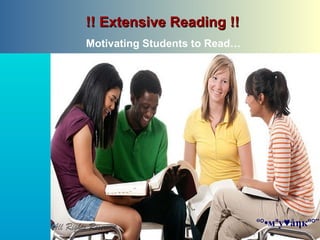
!! LovE ReadinG !!
- 1. !! Extensive Reading !! Motivating Students to Read… º°•мªy♥åηкº°¨
- 3. The value of extensive reading
- 5. It is an important source of ideas and information It can nurture a good reading habit
- 6. Cycle of growth Extensive reading – increased exposure – cycle of growth (Nuttall 1996) Extensive reading helps student to become fluent, independent readers who are interested in reading. Read more Enjoyment Learn more Enjoy more Read faster Sustained exposure / reading habit Language improvement
- 7. Improving the extensive reading lessons and encouraging students to read extensively
- 17. Suggestions for helping students overcome these problems Cloze reading (to develop ability to tolerate vagueness and to guess words from context) Think-aloud protocol (to help develop awareness of the importance of background information) Predicting the ending of short stories Discussion of plot, characters, setting, problem, resolution etc through story frames and story maps Read more!!! ‘We learn to read by reading’ (Smith 1978, Nuttall 1996) References Nuttall, C (1996) Teaching Reading Skills in a Foreign Language. London: Heinemann Smith, F (1978) Reading. Cambridge: CUP
- 19. Creating a reading community in class (Peer support and sharing are essential) Suggestions Literature circles Readers’ and writers’ workshops Readers’ theatre Conferencing with and writing to book authors Publishing students’ stories in the form of ‘small books’
- 20. Providing a print-rich environment (Easy access to books is important) Suggestions: Class libraries Display corner for ‘Book of the month’, ‘Author of the month’ Display corner for students’ work e.g. letters to the authors, book cover design.
- 21. A whole school approach Eg. Book week to celebrate literacy: - Book character day - Graphic display of number of books read by the entire school in the form of a bookworm that ‘grows’ around the school - Book talks by authors and community leaders 4. Developing a reading culture in school
- 22. Display of English books in the library – a book corner (Change it every month) – can adopt a theme (Detective stories) or an author approach (Roald Dahl) Display of students’ work, like book reviews, letters to the authors, book cover designs Board displays with slogans – e.g. Reading is fun! Activities to promote reading e.g. story-telling competition, drama competition, book report competition, best readers of the class, the form, the month etc.
- 23. Surveys on books Teachers’ recommendations (the ten best books) in school newsletters Opportunities to borrow books in the summer and the holidays Enlist the help of parents
- 24. Integrating extensive reading into the TBL curriculum
- 26. For example Task: Write a letter to a friend asking for help and advice Students each choose a character from a book they have read. They pretend to be the character and write the letter e.g. The Pied Piper of Hamelin - The mayor of the town asks a friend to suggest ways of getting rid of the rats. The Three Little Pigs – The pigs ask for ways to protect themselves from wild animals Task: Produce a radio play Students who have read the same book can work as a group to produce a radio play based on the book ie. different groups will produce different plays
- 27. Task: A project based on the theme ‘Animals’ Students can make use of the animal stories / books they have read in doing some of the tasks, e.g. they create / publish their own animal stories in the form of small books. Task: The most popular character Each student nominates a character from the books he/she has read and draws a picture / writes a short description of the character. The whole class vote to decide on who the most popular character is
- 28. Task: Students create a new ending to a story they have read Task: Students design new book covers, book marks or cartoon strips based on a story they like There is more variety in the students’ work because they have read different books
- 29. Conclusion